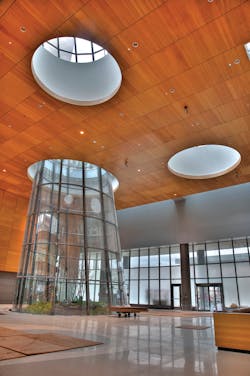Rush University Medical Center: New Tower the Gem of Chicago
There’s an old saying that too many cooks spoil the broth. In the instance of a new $654 million healthcare facility in Chicago that definitely wasn’t the case. The spirit of cooperation loomed large and moved Rush University Medical Center’s new 14-story tower into the future and beyond with the latest healthcare, security and technological deployments.
There were many ‘cooks’ involved, including an electrical contractor (EC), an integrator with an existing relationship forged on an access control system and surveillance installation/upgrade in the older buildings on campus, and a new integrator brought on board by the EC—but it worked meticulously, with planning, meetings and updates of specifications peppered with generous doses of input from in-house security management, engineering, facilities and IT teams. The end result is a gem of a building on the near West side of Chicago overlooking the Eisenhower Expressway.
State of the art and of the future
Referred to simply as The Tower, Rush University Medical Center has applied for Leadership in Energy and Environmental Design (LEED) Gold certification from the U.S. Green Building Council. The atrium of the new building, called the Edward A. Brennan Entry Pavilion, is highlighted with an expansive floor to ceiling glass cylinder that’s an indoor terrarium of such and includes trees and soil in a continuation of a green roof design atop the structure. It also masks a more practical use—panels on each side of the pillars are designed to provide oxygen, electrical and other medical necessities in the event of a major catastrophe in which the pavilion can morph into an expanded emergency room.
The Campus Transformation Project, designed by Architect Ralph Johnson of Chicago firm Perkins+Will was in the planning stages for several years and opens to patients this month. The Tower adds some 300-plus new adult and critical care beds, bringing the hospital’s total to close to 700 and making it one of the largest medical complexes in the area.
Geriatrician Dr. Anthony Perry led the Rush Transformational Team, a group charged with planning the new building and spearheading the healthcare provider’s goal to recommit to its campus in the Illinois Medical District and secure funding through donations and city, state and federal grants. Other highlights of the new medical center design include:
Butterfly-shaped floors which maximum existing light and centralize caregiver and nursing areas,
An emergency room that is part of a new bioterrorism and major disaster response plan for Chicago paid for by a $7.5 million grant from the McCormick Foundation and grants from the federal government. (The former emergency room, which is in one of the campus’ older buildings, will be razed after the new building opens.)
- The ability of each room to contain and dispel contaminated air from highly contagious patients,
- An ambulance bay area that can convert into a massive decontamination room,
- A surveillance system that can trace disease as it spreads across the city,
- A new central command and control center for security and surveillance, and
- Upgraded and integrated video and access control systems with multi-use identification cards.
Lauris V. Freidenfelds is the Director of Security and Emergency Management at Rush University Medical Center and is proud of the technological advances in the way of security as well as others that have been implemented in the new tower. The goal and end result of the new security installations, he said, were to integrate intrusion detection, patient wandering, infant abduction, duress, surveillance and access control in a converged solution that assists in the safety of employees, patients and visitors.
“Our goal was comprehensive visual and alarm notification,” Freidenfelds said. He added that the medical center’s duress system will be integrated with radio frequency pendants worn by nurses for instant and immediate notification of location and events.
“It’s an on-stage, off-stage type of configuration,” he explained. “We have segregated areas where visitors and patients belong and back areas where we have the transport of patients; those areas are segregated from the general public,” he said.
There were many challenges to the specification and final opening of the medical center tower, one of which was the overriding presence of many different entities and regulatory agencies, including the city of Chicago and its own building, fire and occupancy codes; the Emergency Department and its needs; the Illinois Department of Health and Human Services; and the fact that the organization is a teaching hospital. As an academic facility, the proximity access control system is used not only by staff but students as well. Higher security areas in the hospital deployed fingerprint biometrics for access control.
“What’s really challenging and unique is our identification card visitor management system, in that it’s going to be integrated to duress functions. Our identification card is a multi-purpose, multi-technology card and we rebadged 10,000 people in a two-week period. The badge is visual identification and also contains a bar code for time and attendance and for students visiting the library. We have it integrated into the C-CURE 9000 security and event management system by Software House (a Tyco International Co.) and Human Resources Department databases,” he said.
Advent Systems Inc., based in Elmhurst, Ill., was the original systems integrator on the job at Rush University Medical Center and is handling the tie-in and integration to the new tower location, according to John T. Skwirblies, senior account executive. Advent Systems was the installer of the system at the existing campus and has been upgrading and migrating the older facilities from C-CURE 800 to the 9000 version of the software and is now carrying that work into upgrades and integration in the new medical tower.
“We have been doing the upgrade to the 9000 version in the existing buildings on the campus and are handling programming and providing the integration with 9000 to American Dynamics VideoEdge NVRs,” he said. Skwirblies said Advent spent some 300 programming hours getting the new tower’s system in place for the opening in January, and the systems integration firm continues to provide testing, service and maintenance to Rush University Medical Center.
Skwirblies said working for healthcare end users in older facilities, as Advent has done for many years at the Rush campus and others, can be a challenge. “From an installation point of view, hospitals are definitely more challenging than an office facility. We had to do tenting and had to be particularly careful in intensive care units and patient hallways. Everything had to be run in conduit. It really helps to have a good rapport with security departments, the IT side, facilities management and engineering. These are the folks who know all the wire runs,” he said. (Advent Systems is an independent systems integrator and member of Security-Net, a global provider of security services.)
Advent Systems worked in tandem with the integrator charged with the new tower facility, Siemens Industry Inc., Buffalo Grove, Ill., to make certain solutions were seamless and met the end user’s expectations. Siemens Industry Inc. was brought into the new tower installation through a Request for Proposal by The Tower’s electrical contractor, Gurtz Electric Co., Arlington Heights, Ill.
When Rush University Medical Center’s new tower was initially in the works, several years ago and equipment specifications documented, technology was quite different. Over the last few years, with new advances in IP cameras, wireless, and other connectivity, change orders were a necessity, according to Darrin Doan, senior sales executive, Fire Safety and Security, Siemens Industry Inc.
“It’s been a challenge, because technology has changed dramatically since the specification was first written several years ago,” Doan said. “There were a lot of steps to take and weekly meetings with the end user. New products coming out took longer than anticipated. It was a big job and a lot of people were involved, including the owners,” he said.
An overriding challenge was not only bringing the specification up to speed but also determining where to place access control readers due to the large number of elevators in the facility. “It’s difficult to test wireless locks when you don’t have a final structure in place,” Doan said.” We used pin modules to transmit to the wireless locks and back to the controller. We had to be sure the door locks would communicate properly,” he said.
Siemens also handled integration into the new onsite command and control center and tied older analog cameras (although all new surveillance is IP) into the control center with encoders.
“It was critical to do a lot of consulting work with the hospital, and that’s definitely where we excelled,” Doan said. “Sometimes it meant a change order and that wasn’t initially well received but it saved headaches for Rush University Medical Center down the road,” he said. In addition to installing some 300-plus IP cameras, mostly Sony and some Arecont, Siemens also installed some 650 wireless door readers (Ingersoll Rand Security Technologies Schlage AD-400); 350 hardwired door readers from HID and also integrated new IP cameras to the American Dynamics (a Tyco International Co.) victor video management system that enables users to use both analog and IP cameras and provides a single solution to manage recorded video from VideoEdge NVRs.
Siemens Industry Inc. has been on the job since about 2009 and over the last year has spent about 1,800 hours at the hospital’s construction site, with about five technicians on the job.
The new building has been a long time vision of the Chicago medical community and Rush University in particular and positive results are now tangible in The Tower. “This was an example of a great collaborative effort between security, engineering and facilities management to make it all happen,” Freidenfelds said.



